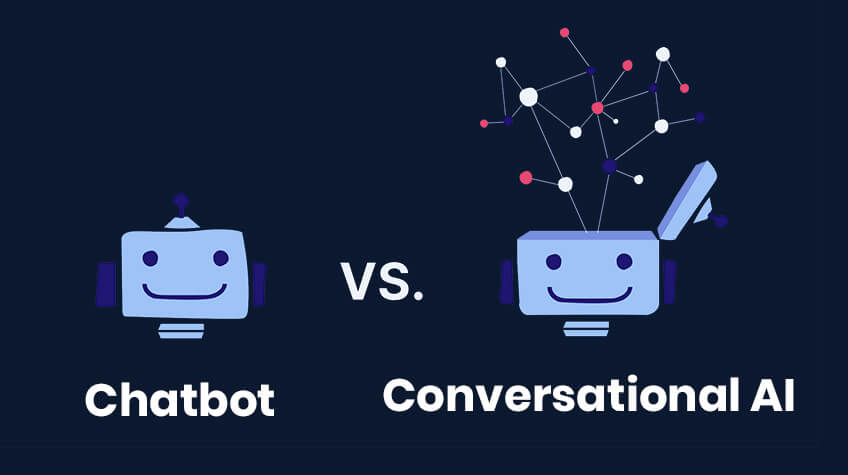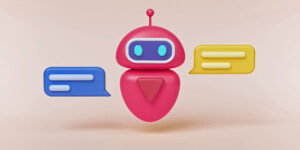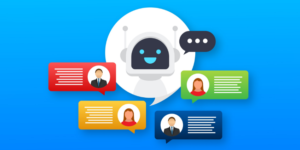
A chatbot is a computer schedule developed to simulate dialogue with actual visitors, especially over the net. A conversational AI, on the other hand, is a more advanced form of chatbot that uses natural language processing and machine learning algorithms to enable more human-like, intelligent conversations.
Introduction
A chatbot is a computer program developed to imitate talks with real users, particularly over the net. Chatbots are frequently used in consumer assistance, trade, and other fields where they can interact with humans naturally and intuitively using text, voice, or even video.
Conversational AI directs to artificial intelligence technology that helps computers to communicate with humans naturally and expressively, often through chatbots or virtual associates. These techniques use state-of-the-art programming and machine learning methods to understand and interpret user input and design relevant answers quickly. With conversational AI, companies can automate customer assistance and support tasks, improve marketing efforts, and enhance the buyer experience.
What are chatbots
A chatbot is a computer schedule developed to imitate talks with actual visitors, particularly over the net. Chatbots are frequently used in consumer assistance to respond to asked questions and help customers fix problems. They can also be used in other areas, such as entertainment, where they can be programmed to tell jokes or provide information on a particular topic.
One of the significant advantages of chatbots is their capacity to deliver immediate assistance to users. In addition, unlike a human customer service representative, a chatbot is available 24/7 and can handle multiple interactions simultaneously. This makes them an efficient and economical resolution for companies.
Another benefit of chatbots is their capacity to understand and adjust over time. As they interact with more users, they can improve their responses and become more efficient at assisting customers.
There are two significant kinds of chatbots: rule-based and AI-powered. Rule-based chatbots follow predetermined rules to respond to user inputs, while AI-powered chatbots use machine learning algorithms to improve their responses over time. AI-powered chatbots are generally more advanced and able to provide more personalized assistance to users.
They are usually employed in consumer assistance to respond to frequently asked queries, help customers resolve issues, and can be programmed for other purposes. Chatbots are available 24/7 and can handle multiple interactions simultaneously, making them an efficient and cost-effective solution for businesses. They can also improve their responses over time by learning from user interactions. Whether you run a small retail shop or a large enterprise, there is likely a chatbot idea that can benefit your business.
What is Conversational AI
Conversational AI uses artificial intelligence (AI) to enable computers to conduct natural, similar-to-human dialogues with customers. It is a subfield of AI that focuses on developing systems that can comprehend, interpret, and demonstrate identical to human language.
One of the primary uses of conversational AI is the growth of chatbots. These computer programs are developed to simulate dialogues with actual users, often over the Internet. For example, Chatbots can be utilized in customer assistance to respond to frequent queries and help customers resolve issues. They can also be programmed for other purposes, such as entertainment.
Another application of conversational AI is developing virtual aids, such as Apple’s Siri or Amazon’s Alexa. These assistants can understand and respond to voice commands and perform various tasks, such as setting alarms, making phone calls, or providing information.
Conversational AI is made possible by advances in natural language processing (NLP), a unit of AI that prospers in the interconnection of computers and human beings through simple language. NLP algorithms are employed to study and comprehend human speech and can be used to generate responses that are appropriate and contextually relevant.
Conversational AI is a subfield that focuses on enabling computers to conduct natural, human-like conversations with users. It is used in developing chatbots and virtual assistants and relies on natural language processing algorithms to understand and respond to human language.
Chatbots vs Conversational AI
Chatbots and conversational AI are often used interchangeably, but they are different. Chatbots are computer schedules developed to imitate discussions with human users. At the same time, conversational AI refers to using artificial intelligence (AI) to enable computers to conduct natural, human-like conversations.
One of the main differences between chatbots and conversational AI is the level of intelligence and autonomy. Chatbots are typically rule-based, meaning they follow predetermined rules to respond to user inputs. As a result, they need to be more comprehensive in understanding and interpreting human language and may provide repetitive or generic responses.
On the other hand, conversational AI is powered by machine learning algorithms that allow it to improve its responses over time and provide more personalized assistance to users. As a result, it can understand and interpret human language more accurately and generate appropriate and contextually relevant responses.
Another difference between chatbots and conversational AI is the task span they can complete. As a result, chatbots are often limited to performing specific functions within a narrow domain. At the same time, conversational AI can handle a more comprehensive range of tasks and can be applied to a broader range of applications.
However, chatbots are typically limited in their ability to understand and interpret human language, while conversational AI can provide more personalized assistance and handle a broader range of tasks.
Which is better suited for business
Both chatbots and conversational AI can be helpful for businesses, depending on the specific needs and goals of the organization.
Chatbots are used in client assistance to reply to queries and help customers fix problems. They are available 24/7 and can handle multiple interactions simultaneously, making them an efficient and cost-effective solution for businesses. They can also be programmed for other purposes, such as lead generation or selling.
Conversely, conversational AI is better suited for businesses that require more advanced and personalized assistance. This is because it can understand and interpret human language more accurately and provide appropriate and contextually relevant responses. This makes it well-suited for applications such as virtual assistants, where it can handle a wide range of tasks and provide more personalized assistance to users.
Ultimately, the choice between chatbots and conversational AI will rely on the precise requirements and purposes of the business. Both can be valuable tools for improving customer service and automating particular tasks, but conversational AI is generally considered more advanced and can provide more personalized assistance.
Benefits of conversational AI over traditional chatbots
Improved understanding of human language: Conversational AI can understand and interpret human language more accurately than traditional chatbots. This permits it to deliver more individualized and contextually appropriate reactions to users.
Greater autonomy: Because machine learning algorithms power it, conversational AI can improve its responses over time and become more autonomous. It can learn from user interactions and adapt its responses accordingly, making it more efficient and effective at assisting users.
A more comprehensive range of tasks: Conversational AI can handle a wider range of tasks than traditional chatbots. It can be used for a wider range of requests and provide users with more personalized assistance.
Enhanced user experience: The ability of conversational AI to understand and interpret human language more accurately leads to a better user experience. In addition, users are more likely to feel satisfied with the assistance they receive from a conversational AI system, as it can provide more relevant and personalized responses.
Increased efficiency: Because conversational AI can handle a broader range of tasks and improve its responses over time, it can help businesses to become more efficient. It can automate specific tasks and allow companies to redirect their resources to more critical studies.
How to get started with conversational AI?
If you are interested in getting started with conversational AI, there are a few steps you can follow to get started:
Determine your goals: The first step in getting started with conversational AI is to determine your goals. What do you expect to gain by executing an informal AI system? Are you looking to improve customer service, automate specific tasks, or do something else? Clearly describing your plans will allow you to decide the best approach for implementing conversational AI.
Choose a platform: Several platforms are available for developing conversational AI, such as Google Dialogflow, IBM Watson, and Amazon Lex. Each platform has features and capabilities, so choosing one well-suited to your needs is essential.
Determine your use case: Once you have chosen a platform, you will need to determine the specific use case for your conversational AI system. This will involve identifying the tasks you want the system to perform and the interactions it will have with users.
Build and test your system: The next step is to build and test your conversational AI system. This will involve creating the necessary dialogue flows and integrating the system with your chosen platform.
Employ and monitor: Once your conversational AI system is made and tried, you can use it to interact with users. It is essential to monitor the execution of your system and make any crucial changes to enhance its significance.
By following these steps, you can successfully implement a conversational AI system that meets your needs and helps you to achieve your goals.
In conclusion, chatbots and conversational AIs are valuable tools for automating communication and assisting users. However, conversational AIs represent a more advanced form of technology, with the ability to understand and respond to complex and contextually relevant queries. While chatbots can handle simple interactions, they may need to provide a different level of sophistication and intelligence than conversational AI.
As a result, conversational AIs may be better suited for more demanding and nuanced use cases, such as customer service or virtual assistants. Therefore, we hope this article on ‘Chatbot Vs Conversational AI: What’s the difference’ is useful to the readers.






